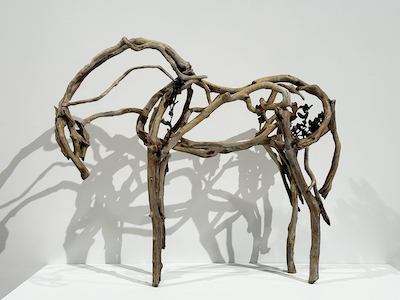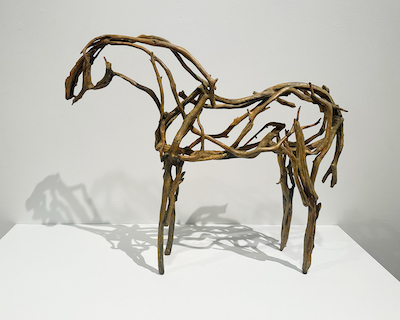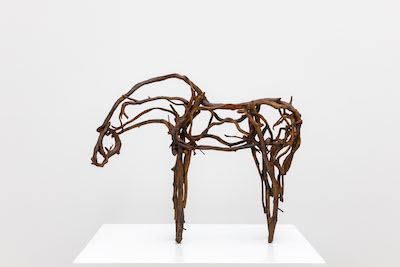RECENT PRESS:
January 7, 2024
The Square Cylinder
Deborah Butterfield at Manetti Shrem
by David M. Roth
Deborah Butterfield's solo exhibition, "Deborah Butterfield: P.S. These are not horses" at the Manetti Shrem Museum of Art continues through June 24, 2024.
CITATION
This sculpture was named after the important racehorse, CITATION, which was one of the most respected American Thoroughbreds in history. In 1948, Citation won the Triple Crown, the 8th American horse to do so, and was the first horse to win $1 million in prize money. It is not, however, a portrait of this horse. The artist keeps names of beloved horses in mind when she titles works. This was a sculpture that Deborah felt worthy of such a name.
The sculpture has the appearance of sun bleached driftwood.
HOPE
The title for HOPE refers to Ed Keinholz and Nancy Reddin Keinholz's Idaho art gallery, The Faith, Hope and Charity Gallery, from the 1970s.
The wood originally used for HOPE is quite varied in comparison to many other large works by Butterfield and, at nearly 8 x 10 feet, is one of the largest works we've had recently. Most of the standing horse sculptures, like HOPE, have the head and neck in an upward, even reaching, position suggesting a horse that is alert and paying attention.
CHEW
The descriptively appropriate title for this sculpture derives from the wood collected from trees that were chewed by beavers near the artist's home in Montana. It took Deborah a long time to collect enough of the wood to build this medium sized horse. All the bark was chewed off and removed so that only the raw wood remained. Because they gnawed randomly on the branches, the beavers' teeth marks can be seen throughout the work.
SANCAI AND KĀPENA
SANCAI AND KĀPENA are the two smallest pieces in our 2023 exhibition and are each from a variable edition of 5.
The basic structure of branches and sticks create the edition matrix, each piece in the variable edition will be patinated differently.
SANCAI is a Chinese word, meaning "three colors," for a Tang Dynasty glaze developed in the late 7th century. The combination of colors is historically white, amber, and green and, though Butterfield's sculpture is not literally a blend of these three colors, the artist was thinking of the Tang Dynasty horses she has seen while she patinated this work. The colors in this patina are of bleached Ō'hia wood, sand, and terra cotta.
In addition to the variable patination within the SANCAI edition, variable attachments of bronze cast leaves and flowers from the Ō’hia Lehua tree are welded on by the artist. Many native Hawaiian traditions refer to the Ō’hia Lehuna tree, and the forests it forms, as sacred to Pele, the volcano goddess, and to Laka, the goddess of Hula. Ō’hia trees are resilient, growing easily on lava, and are usually the first plants to grow on new lava flows.
KĀPENA is Hawaiian for Captain, the name of what Deborah Butterfield refers to as "one of my great horses." Its construction conveys the form of a horse perfectly. The sticks and twigs resemble the gestures in a sumi ink drawing.
KAI MALO'O
KAI MALO'O, a Hawaiian term meaning "dry sea, low tide," has a rich mix of textures in its composition. Some components are stalks of bamboo. Other parts have deeply etched wood grain. Running the length of the body are vine-like sticks that create a tangle of lines resembling kelp or seaweed. The highly contrasted values of light and dark give the sculpture a wet sheen as if it has just washed ashore.
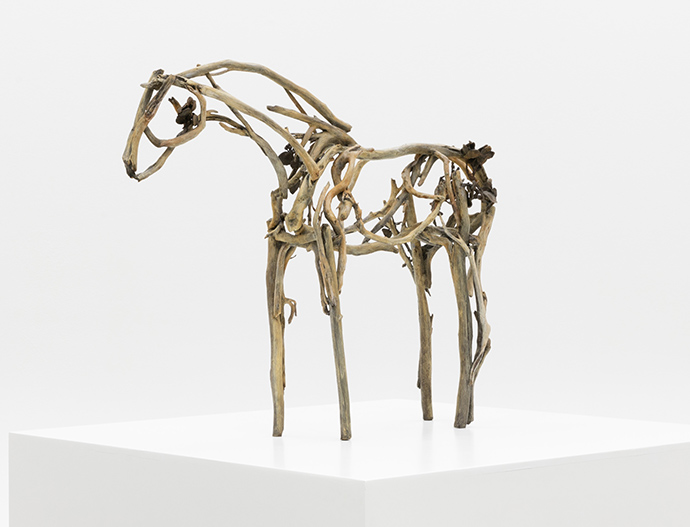

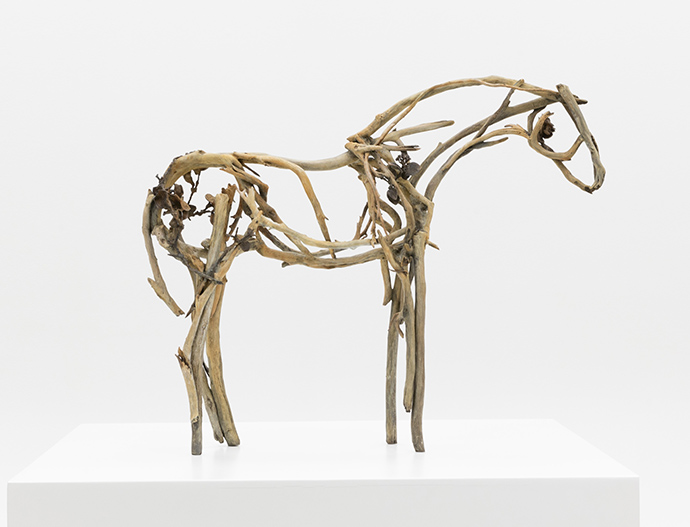
ŌHIA ĀPANE, 2021
Unique cast bronze
26 x 32 x 9 inches
SOLD
ŌHIA ĀPANE
Deborah made this work in her studio on the Big Island. The wood for her sculptures with Hawaiian names comes from walks she takes on her property where she and John Buck live during the winter months. Vegetation there is always sprouting, growing, blossoming, ripening, wilting, dying and decaying. The tropical nature of it just speeds up the process so there are always sticks and branches to pick up.
The Ōhia trees are particularly messy and are always blooming and then dropping twigs. leaves, and flowers on the ground. The small flowers and leaves of the tree are added to this sculpture to mimic what Deborah sees in her nature walks. They are cast in bronze and welded to the limbs and branches after the rest of the work has been cast and reconstructed.
ŌHIA ĀPANE is Hawaiian, meaning "red blossoms from the Ōhia tree."
MUGO
The wood used to create this sculpture came from a large overgrown Mugo pine tree in Greg Kucera's garden that had developed boles on the branches. When the tree finally died, and it had to be cut down, Kucera saved the branches knowing Deborah would be attracted to them. She made this sculpture from them –boles and all.
GARNET and PORTAL
GARNET and PORTAL were created from driftwood collected along the Gallatin River, MT and Shoshone River, WY.













